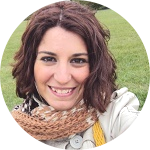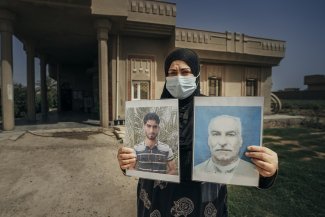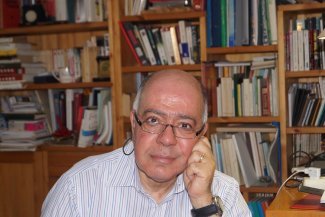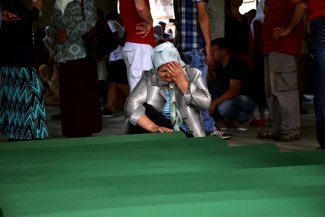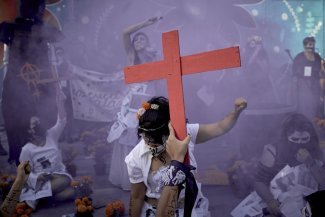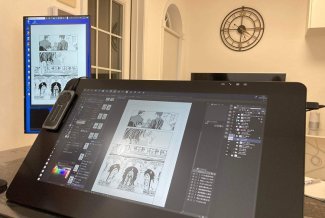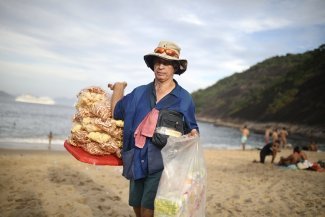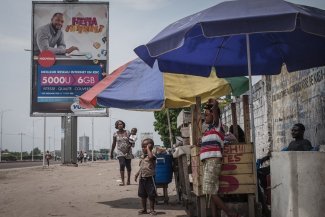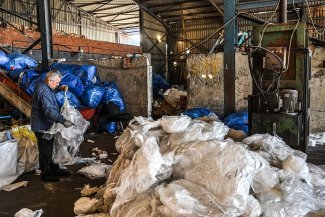In this photo, a mass grave in the Víznar ravine, Granada, February 2024. The search for persons disappeared during the Spanish Civil War, a search backed by the United Nations and overshadowed by political debate, has resulted in the exhumation of just 800 mass graves over the last two decades, out of a total of around 3,500. It is a fragile advance that risks being stopped in its tracks.
Three people work in silence over a hole in the ground. They are hunched over, on their knees. One of them lays down to make it easier to manoeuvre. In front of them is a collection of bones: arms, pelvis, ribs emerging from deep in the ground; skulls too, several of them. At least five can be seen from above. Below, there are at least five more.
We are in the Víznar ravine, in the province of Granada, Andalusia, Spain. Between September and November 1936, at the start of the Spanish Civil War (1936-1939), at least 173 people were killed here and thrown into mass graves. Earlier, in July and August – just after the military coup d’état that triggered the war – there had been more, including the assassination of the poet Federico García Lorca, but no record was left of them.
Since 2021, a team led by Paco Carrión – made up of archaeologists, geophysicists, anthropologists, forensic experts and historians – has been tasked with finding as many of them as possible. They have located 16 mass graves and recovered 116 bodies so far. Thirty-four women, the rest men, all from the Republican side, all civilians, ordinary people – peasants, workers, teachers, weavers – all killed and buried, no one knew quite where. This is why georadar equipment, metal detectors and electrical tomography are being used to locate the graves, technology that is combined with more rudimentary tools – a fine paintbrush, a vacuum cleaner – to bring the bodies to light. It is slow, painstaking work.
“It can take a month or so, about three weeks for each mass grave, from the moment we start the excavation to when we exhume the bodies, document them and photograph them. It depends on the number of people. In this one, for example, there are ten, but the terrain tells us that there may be more underneath,” Félix Bizarro, one of the archaeologists, tells Equal Times. And this is only the beginning. They then have to extract, sift and analyse not only the bones but also the personal effects – earrings, rings, trouser buckles – essential to identifying, together with the DNA samples, each body, and giving them back their name. This is the real purpose of the whole process: to identify them and hand them over to their families, who have been waiting for more than 80 years. The length of this wait illustrates the dilemma of Spain and its memory, so difficult to dig up.
The search for the disappeared, backed by the United Nations and overshadowed by political debate and its vicissitudes, has only led to the total or partial exhumation of 800 mass graves over the last two decades, out of a total of around 3,500. It is a fragile victory, with constant advances and reversals, periods of support and periods of total abandonment. Today, work is underway in graves such as the one in Víznar, but there is no guarantee that it will not be stalled once again.
The first exhumations
There is no certainty over how many people were killed in the Spanish Civil War. The figure usually used as a reference, by the Hispanist Paul Preston for example, is 150,000, some 100,000 of whom died at the hands of the insurgents led by General Francisco Franco and just under 50,000 at the hands of the Republicans. They were all victims, but they did not all receive the same treatment.
“The first memory policies were made only for the dead on one side. During the dictatorship, orders were issued to exhume those executed or disappeared at the hands of the Republicans – around 33,000 were moved to the Valley of the Fallen, which was built as a gigantic memorial. But the same policies did not apply to all: the exhumation of those executed by Franco’s troops was not permitted,” says Matilde Eiroa San Francisco, doctor of contemporary history at the Carlos III University in Madrid.
The violence did not, moreover, end with the war. The repression subsequently exercised by the Franco dictatorship (1939-1975) kept adding to the number of disappeared. The exact figure remains unknown to this day. The only document that states a figure is a 2008 ruling by a National Court judge at the time, Baltasar Garzón, who, based on the testimony of family members, quantified the number at 114,266 people, although this is not a definitive figure either.
The silence imposed by the dictatorship, as well as during the early decades of democracy, in the name of supposed national ‘reconciliation’, prevented the victims’ families from reclaiming their remains. Some searched for them on their own, in secret. It is known that between 1978 and 1979 – after the death of the dictator – several children of the disappeared clandestinely opened mass graves, with their own hands. But people did not start to speak out freely until the next generation came along.
“The visibility of memory is founded on the mobilisation of the grandchildren’s generation,” says Eiroa. “It was a historic breaking of the silence. Social media played a key role, helping them to unite and to form a community.”
The year 2000, 60 years after the end of the Civil War, saw the first exhumation of a mass grave using scientific methods. Thirteen men were recovered in the municipality of Priaranza del Bierzo (León). One of them was Emilio Silva’s grandfather. “If it hadn’t been for the families and the grandchildren, it would have passed on in silence, just as it was after Franco’s death. We, the grandchildren, were not part of the plan, we were not on the roadmap,” says the current president of ARMH, the main historical memory association in Spain.
2007: an incomplete law
In 2009, Paco Carrión went from studying fossils from four or five thousand years ago to looking for victims of the civil war. He was one of the first. “I think it was a debt that our country had pending,” the archaeologist and geophysicist from the University of Granada tells Equal Times. The early days were not easy. Those who were looking into the more recent past were not seen in the best light, and they worked on their own. Now, by contrast, Paco Carrión has a multidisciplinary team of professionals working not only in Víznar but also in Cordoba, on other mass graves spread over two sites.
Carrión was able to work on these exhumations thanks to the impetus provided by the 2007 Historical Memory Law, an initiative of José Luis Rodríguez Zapatero’s socialist government which, for the first time, included recognition of all the victims of the war and the dictatorship, and established the commitment to support the search for the disappeared with public funding. The law was criticised by conservative sectors, fearful of ‘reopening old wounds’, but was also censured by the families and the UN for not going far enough, as although the state helped to finance the search, it did not take ‘responsibility’ for it, leaving it in the hands of the families.
Some time later, UN special rapporteur Pablo de Greiff criticised the “privatisation of exhumations”, with all responsibility and even the hiring of archaeologists being left to the victims themselves.
The UN-established right to truth, justice and reparation was not sufficiently protected, so when Mariano Rajoy of the conservative PP came to power in 2011, he did not repeal the law but he did remove the funding for it. Dozens of projects came to a standstill. Family members had to pay out of their own pockets for procedures they were entitled to. A few regional governments continued to provide funding, but still it was not enough to pay the teams. Despite being a signatory to the International Convention on Enforced Disappearances, Spain once again turned its back on its disappeared.
A new law and a new threat
The soil in the ravine of Víznar has managed to preserve the bones remarkably well. This is a great help, especially for forensic anthropologists such as Laura Gutiérrez. Her task is to identify the sex and age of the victims – most of them here are between 25 and 35 years old – the perimortem injuries and the type of violence suffered. “Almost all of them were executed with a pistol, close to or touching the skull. They usually have more than one gunshot wound: two, three, four, up to six in the skull alone,” she explains. This is also what exhumations are for: to find out what happened.
The project in the ravine, which is in its fourth and final phase, is now funded by two administrations – the state and the regional government – and is being conducted under the new Democratic Memory Law, passed in 2022 to replace the old law, following the coming to power of a new socialist government, that of Pedro Sánchez. His term of office began with a declaration of intent: the exhumation of the tomb of the dictator Francisco Franco in the Valley of the Fallen and its relocation to a private burial place. This was followed by the reinstatement of funding for exhumations and the new law.
The difference with the previous law, notes Professor Matilde Eiroa, “is that the state now takes responsibility, takes on the costs, and accepts that it is also part of its responsibilities to provide a solution”. This means that the search has become a public undertaking, the administrations – including local and regional authorities – take the initiative, and the funds are allocated every four years under a four-year plan. “We now have significant funds that enable us to have a professional team and a wider timeframe in which to work,” says Carrión.
In the first two years since the new law came into effect, 4,500 bodies have been recovered. In the whole period between 2000 and 2019, only 9,700 were exhumed. The pace is certainly picking up, but for some it is still not enough.
“We are quite critical because the model has not changed with the law, it continues to be that of subsidising the search for the disappeared,” says Silva. “What they should have done was to create an office that does not depend on the political colour of the government. When the government changes, we don’t debate whether the rights of the victims of terrorism are in danger; the same should be true for the victims of Francoism.”
This way, he argues, the fear of the future would be avoided. The fear is the repeal of the law, as threatened by conservatives on the right and the extreme right. This threat has already been acted on in regions such as Cantabria, which is governed by a PP and Vox coalition.
While it is true that other conservative governments such as that of the PP in Andalusia are maintaining the support for projects such as Víznar, for now, it seems clear that the exhumations are on shaky ground. “Of course we are afraid of a reversal,” says Carrión. “This should be kept out of politics. What we are doing is humanitarian.” As reported in El País, the current UN rapporteur, Fabián Salvioli, agrees: “These are not matters that a state can be selective about. They are legal obligations that derive from international commitments.”
How, then, can the political polarisation be taken out of this issue? According to Silva, the answer is to build “a culture of memory” and this can only be achieved by “bringing all the political forces on board. We have to invite them to acts of remembrance, open the door to them. They should all go to an exhumation.”
“Bury him by my side”
“The aim of an exhumation is not only to recover the victims in physical terms, to recover their bodies, but also to recover their lives, their biographies, to reconstruct who they were.” These are the words of sociologist Fran Carrión. His work on the graves in Víznar is almost as delicate as sifting through the soil. He is the liaison with the relatives. “This is a group of people who have been seriously neglected for decades. They’ve had to put up with being ignored for years, with no acknowledgement of their pain. The interaction with them is very moving.”
He provides them with daily updates on the progress of the exhumation, through a WhatsApp group, answers their questions and gives them as much support as possible. There are more than 100 of them: a few of the children are left, but they are mostly the grandchildren and great-grandchildren. “A war is not over until there is peace in our hearts,” says María. She is 67 years old and the granddaughter of a disappeared person. Her grandfather Francisco is one of the 173 people that, according to historical documentation, are in the ravine. He was a cultivated peasant, linked to trade union movements, born in Fuente Vaqueros, like Lorca, and was killed a month after him.
“I knew from a very young age that my grandfather was killed in the war, but my mother didn’t talk about it, she was afraid all her life. When I was older, I found out he was here,” says María. “I think about him a lot. I haven’t met him, but it’s as if he were within me. He’s part of me, because I have part of his blood in me.”
María, like 40 other relatives, has provided samples of her DNA to be checked against the bones that are found, to try and find a desired match. Those that are identified will be returned to their families, those that are not will be buried with dignity in a memorial. Still, the hopes are managed with caution. Only one in three bodies – at best – is usually identified by DNA, with genetic chains altering with each generation. Memory has no worse enemy than the passage of time. If one body turns up, we will all cry,” says María, “And we will all go to that burial because it will be part of our grandfather.”
The DNA results will still take time, they will require a little more patience, but nothing compared to how long they have already had to wait. “My grandfather’s place has been kept in the cemetery, to the right of my mother,” says María. Before she died, she told me: if you find him, bury him by my side, even if it’s just one bone. I am doing this for both of them. For him and for her.”



